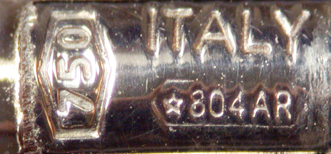

Italian Maker Marks
The last thing you want to do is become an expert on Italian maker marks. However, since they are encountered in the American jewelry market - a basic knowledge is useful. Keep in mind that not all gold and silver jewelry made in Italy will bear these marks. They are required on pieces being sold in Italy or exported to any Euro country and Italian precious metal standards apply by law. However, exportation to non-Euro countries is not within the Italian law's standards.[1]
The Prevailing Mark
In today's gold buying tsunami - many gold chains are being purchased for their gold content. A noticeable number of chains are clearly marked "Italy" quality mark of "14KT." Most of these chains are really not 14KT gold but instead gold plated silver. The chain is not magnetic, will pass a touchstone acid test as if 14KT however, the streak on the touchstone is not the same tone of gold as the chain but, instead, slightly white. More significantly, the quality mark was American - Italians use the millesimal[2] system with 585 being equivalent to 14KT and a country-of-origin mark is rarely seen on actual Italian jewelry. Instead, pieces will usually have a marker's mark accompanied with a quality mark of 417, 585 or750.

Basically, an Italian marker mark has the providence and makers' number. These numbers are sequentially issued. Italian marks have evolved since they were first placed in use in 1935. There have been changes to the outline as well as a state mark. Pre-1934 marks where an elongated oval.[3]
Then, a new shape as well as a symbol representing the Italian fascists - a right facing fasces was used from 1934[4] until 1944.[5] In 1968 a five-pointed star representing the republic of Italy was added and is still in use today.[6] The original outline was a hexagonal until 1968 which then became a elongated hexagonal shape with pointed ends.[7]
Although you may have a mark that was first registered in 1935, it may still being used today. Indicators for a circa date will be the mark style itself coupled with the first registered date (essentially telling you that it can be no older than that date). Additonally, check the trademarks as they may also help date the item.
Provincial Mark
All providences are represented by a two letter abbreviation, except Rome which is spelled out (Roma).[8]
Although addresses are part of a resulting search, the company may not exist or have relocated. It would be onerous to research each of the thousands of markers to determine if they still exist and are at the address. Contact information cannot be guaranteed to be current.
Some Italian companies who export to the United States registered their trademarks with the U.S. government. This is logical and results in providing appraisers with both the Italian maker's mark as well as what the U.S. Trademark service's data. Soon there will be Italian trademarks that are registered in both Italy and other countries for an even more complete research experience. This offers more information on circa dating a piece of Italian jewelry.
The most often seen makers' marks will be from the providences of Alessandria (AL), Arezzo (AR), Milan (MI), Roma (ROMA), Vicenza (VI) and Verona (VR). There are 102 providences that issue markers' marks.
Inc. Italian Style
Incorporated companies, similar to the system in the United States, exist in Italy as well. These are the abbreviations that in essence are equivalent to Inc. or Ltd. in the U.S.:
| S.r.l. | = | SocietÓ a ResponsabilitÓ Limitata |
| S.n.c. | = | SocietÓ in Nome Collecttivo |
| S.a.s. | = | SocietÓ in Accomandita Semplice |
Try It
The entry form is simple. Enter the number and select from the drop down list the providence. You can see displayed the total number of makers' marks in the database - which is growing. The name of the maker as well as when the mark was registered, et cetera and a box with a sentence ready to be copied and pasted into your report. What could be easier?
And, if you request the contact data, the last known address, telephone or internet contact information will be presented. Of course, some addresses are too old to be valid but are included anyhow.
If the marker's mark has also been registered as a United States trademark, then those registerations will also be displayed - each with a sentence ready for copying into your report.
Footnotes: